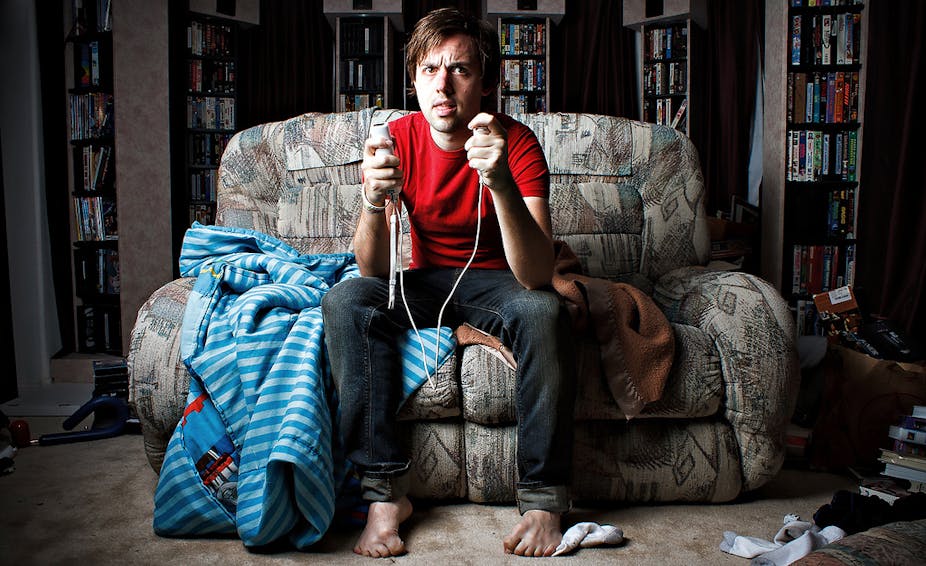Repetition is a rare phenomenon in the real world but a sense of déjà vu is common in the game world. Games made by large studios with massive budgets, often called AAA games, have become ever more detailed, complex and expensive in an effort to reduce every perceptible audio-visual difference between real and virtual environments. All of this in order to give players the ultimate immersive gaming experience.
But at what point does the increase in detail and complexity demand too much of not only the game’s development resources but also the player’s desire to keep playing?
Game development budgets have increased hugely since the 1980s (see graph below). The latest instalment of the Grand Theft Auto (GTA) series by Rockstar games had more than double the budget of its predecessor and cost an estimated US$265 million to make – the most expensive videogame in history.

Game assets such as terrain, characters, buildings, vehicles, sound and music, all have to be manually created which is time-consuming and costly. Game developers routinely reuse assets in the game world to save on time and money, as described below. From a technical perspective, also, the detail and complexity is largely limited by the hardware that dictates the number of objects and the audio-visual detail that can be displayed at acceptable frame rates.

In stealth video game Hitman: Absolution (2012) large crowds were made up of only six to nine base character models. While the developers would have liked to use more character models, the severe memory restrictions of the game platform did not permit that.
People are good at perceiving detail. Japanese robotics specialist Professor Masahiro Mori observed, in what he described as the “Uncanny Valley”, that people react positively to a robot’s appearance as they come to look more human-like … then, with increasing human likeness, as people focused their attention on what didn’t look quite right, the former positive reaction turned into revulsion.
Mori speculated that the acceptance of robots increases again with increasing human likeness. This observation poses a particular challenge for human or humanoid characters in a game, but the problem also applies to all other physical aspects and objects of the game world.
The doing and undoing of repetition
As games thrive towards realism, players more readily compare the game world against the real world and discrepancies become more apparent.
Situations such as the exact repetition of a dialogue, the re-emergence of a previously expired character or the identical copy of an object in the game world, are situations we don’t commonly observe in the real world.
An increase in realism might paradoxically lead to a decrease in believability and significantly limit the longevity of the game.
Repetitive audio can be managed by lowering the sound or turning it off altogether. But repetition in the game world can only be addressed by adding more content. In GTA V the developers “hand-crafted” every aspect of the game world and as a consequence the player encounters less repetition.
This “hand-crafted” approach requires a serious development budget, not commonly available for most game projects. As game worlds, game characters and game interactions become more “realistic” companies have to develop more content and implement more sophisticated interactions to create a convincing world.
There is still a long way to go until the development of more realistic game experiences is less limited by the computer hardware and more limited by budgets, team sizes and production times.
As long as gamers demand higher degrees of “realism”, developers will continue to look for tools that allow artists to craft a game world that reduces the inherent repetition we see in games today.
So, where to from here?
Let’s consider the modernist music of American composers Steve Reich and Philip Glass, German electronic band Kraftwerk, American rock band The Velvet Underground. Repetition or “looping” is an important aspect of all their compositions. Repeated sounds work magic in our brains and this practice led to techno music, primarily designed for dancing.
This approach may assist in making repetition in games less of “a grind” – which refers to the time spent doing repetitive tasks to progress through the game.
3D animation application software – such as Houdini Engine, Substance Designer, SpeedTree and CityEngine – is slowly emerging that exposes elements that can be manipulated by the basic game software or generate unique content.
Software developers will need to change their current way of developing games if true realism is their goal. The blueprints for base objects, animations, sounds and music will still need to be created by artists to a large extent, but software of the type described above will have to become more prevalent, and more sophisticated.
With AAA gaming, there’s plenty to do when it comes to keeping it real.
Are you an academic or researcher working on videogame development? Contact the Arts + Culture editor.

